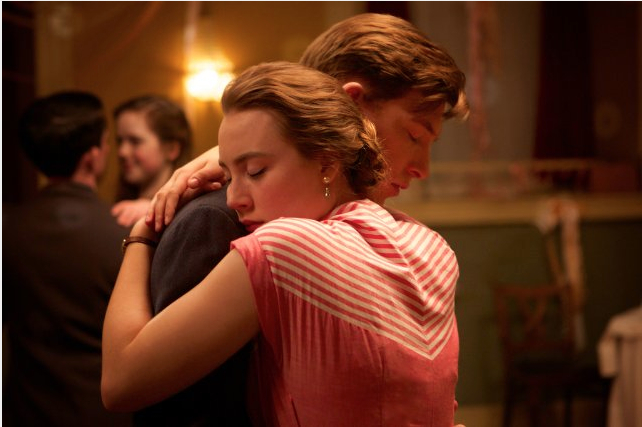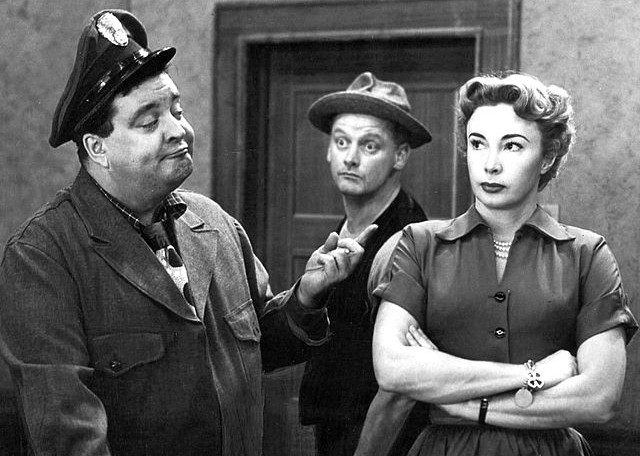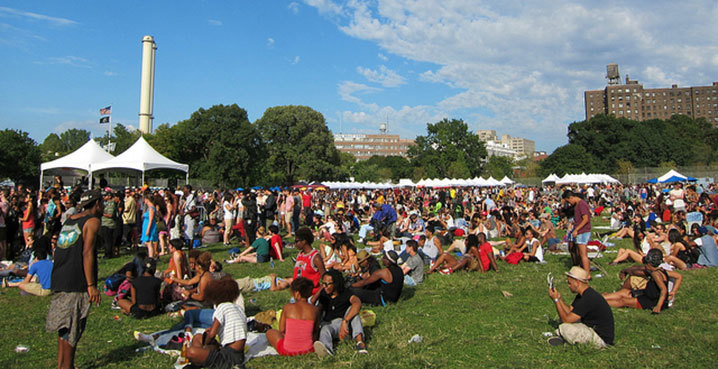With a film version of Colm Tóibín’s 2009 novel Brooklyn, coming to American theaters later this year, Tom Deignan looks at the borough that was home to so many mid-century Irish immigrants.
Back in January, a new generation of Brooklyn high school students were exposed to the beautiful prose of one of Irish America’s most gifted writers, Pete Hamill. “Bridge of Dreams,” an essay by Hamill, was one of the reading passages on the English Language Arts Regents Exam, which every high school graduate in New York State must eventually pass.
“In all years and seasons, The Bridge was there,” Hamill writes, in the essay originally published in 1983. “We could see it from the roof of the tenement where we lived, the stone towers rising below us from the foreshortened streets of downtown Brooklyn.”
Later, the Brooklyn-born Hamill describes the bridge’s special place in his Irish immigrant mother’s heart.
“Awe infused the view of the great harbor, a view my mother embellished by describing to us the ships that had brought her and so many other immigrants to America… all of them crowding the decks, straining to see their newfound land. What they saw first was the Statue of Liberty, and the skyline, and The Bridge. The Brooklyn Bridge…”
Hamill, of course, is only one of many Irish writers who have celebrated Brooklyn. The Bridge itself was built by thousands of immigrant laborers, including a Galway-born teenager named Frank Harris. Before becoming a prominent scholar and author in the early 20th century, Harris was paid five dollars a day to help build the bridge. (When this “Eighth Wonder of the World” opened on May 24, 1883, however, many of the Irish-born laborers wanted no part of the celebration because it happened to coincide with the birthday of Britain’s Queen Victoria.)
Colm Tóibín’s Brooklyn
In Colm Tóibín’s celebrated 2010 novel, simply titled Brooklyn, the trip from Ireland to New York is not exactly filled with romance. Tóibín’s immigrant heroine Eilis Lacey vomits several times during the arduous journey, and upon arrival is told by a fellow Irish immigrant that she looks so “wretched” that if she “did not take care she would be stopped at Ellis Island and put in quarantine.”

A long-awaited film version of Tóibín’s novel will be released in American theaters later this year. The film, set in the 1950s, earned rave reviews after it debuted at the Sundance Film Festival in January.
“Classily and classically crafted in the best sense by director John Crowley and screenwriter Nick Hornby,” The Hollywood Reporter noted, “this
superbly acted romantic drama… provides the feeling of being lifted into a different world altogether, so transporting is the film’s sense of time and place and social mores.”
Brooklyn stars Irish Academy Award nominee Saoirse Ronan, as well as fellow Irish thespian Domhnall Gleeson. Julie Walters, Jim Broadbent, and Emory Cohen round out the cast of Brooklyn, which Variety magazine hailed as “heartwarming and emotional.”
In some ways, Eilis Lacey’s arrival in New York is not so different from the millions of Irish immigrants who came through Ellis Island going all the way back to the first one, Annie Moore, from Cork, in 1892 who went on to marry a bakery clerk and give birth to 11 children.
1950s Immigrants
But Eilis’s journey is also unique in two important ways. First, though fictional, she represents a large but often overlooked wave of real-life immigrants from Ireland who came to the U.S. in the 1950s. Secondly, Eilis – like thousands before her – settled in one of the great Irish cities on the planet, though it is inevitably overshadowed by the magical sliver of land across the East River known as Manhattan.
In his classic study of the New York Irish, Daniel Patrick Moynihan noted that one-third of the population of Brooklyn was of Irish descent by the 1890s. And while Manhattan always had bright lights and tall buildings, Brooklyn was always known as the “borough of churches,” many of them humble, even hardscrabble Catholic parishes founded by Irish immigrants.
Betty Smith provided a vivid snapshot of how the Irish fit into Brooklyn’s broader melting pot in her beloved 1943 novel A Tree Grows in Brooklyn.
With these large numbers came an Irish-dominated social life, from boxing gyms and union halls to dance spots and pubs. It’s no surprise that in Tóibín’s novel, Eilis meets a handsome young man at a parish dance. The surprise is that he’s Italian.
“I heard about the Irish dance and I thought I’d go and look at it and I liked it,” Eilis’ future lover, Tony Fiorello, says afterwards.
In some ways, the social and family lives of Irish immigrants in 1950s Brooklyn were not all that different from previous generations. (The parents in A Tree Grows in Brooklyn are also of mixed heritage, with the father Irish and the mother Eastern European.)
Yet earlier waves of Irish immigrants each had distinct characteristics. Those who emigrated prior to the 1840s were just as likely to be Protestant as Catholic. Immigrants in the middle of the 19th century were escaping the ravages of the Great Hunger. The 1920s saw a wave of immigrants escaping political turmoil and civil war, only to be greeted by a newly resurgent Ku Klux Klan in the U.S., followed by the Great Depression.
The 1950s immigrants from Ireland, however, are much less well known, even though they left Ireland and settled in the U.S. in large numbers.
“Between 1946 and 1961, 531,255 people, almost 17 percent of the population, left Ireland,” Linda Almeida Dowling writes in Irish Immigrants in New York City: 1945 – 1995. “Forty percent of those who were between the ages of 10 and 19 in 1951 were gone by 1961. Most of the migrants went to Great Britain, but 68,151 left for America during and after World War II (1941–1961). It was the largest migration of Irish to the United States since the 1920s.”
She adds, “Several forces combined to push the migrants out of Ireland.” Ireland’s economic outlook remained bleak and this together with a broader sense that “as the world around them moved at a quickening pace, the nation seemed to stand still” pushed “thousands of young Irish off the farms and out of small villages to Great Britain and to the United States.”
In some ways, 1950s immigrants arrived in a city that already seemed to be dominated by Irish Catholics. It’s no accident that early chapters in Dowling’s book bear titles like “When the Irish Ran New York” and “It Was a Great Time in America.”
The Brooklyn Irish
By the 1950s, the Irish had come a long way from the Five Points and Tin Pan Alley. Mayo-born William O’Dwyer was mayor of New York City in 1950, when the Irish-dominated political machine known as Tammany Hall still ran things. The sermons of Bishop Fulton Sheen, meanwhile, were beloved by millions, making him not only a trailblazer who preached Catholic values on the relatively new medium of TV, but also the most popular Catholic priest since the infamous 1930s “radio priest” Charles Coughlin, who was much more combative than the congenial Sheen.
Meanwhile, Cardinal Francis Spellman (who held his post from 1939 to 1967) was so powerful he would later be dubbed an “American Pope” by one biographer.
Irish Americans of more humble means could see themselves in the antics of Brooklyn’s own everyman, Jackie Gleason, one of the top TV stars of the decade.
Even working-class Irish Brooklynites had attained a standard of living their parents and grandparents would never have dreamed of.

“First, second, and third generation descendants of turn-of-the-century immigrants proved to be productive and patriotic citizens,” Dowling writes. “Ethnic Catholics and Jews had achieved remarkable success in politics, labor, business, science and entertainment, among other areas.… Restrictions barring and/or limitings Catholics and Jews to certain colleges and businesses were lifted as the children and grand children of immigrants proved themselves to be active and eager Americans.”
This is the world Ellis Lacey enters in Colm Tóibín’s Brooklyn. Even before she leaves Ireland, she learns a powerful lesson about the extensive Irish Catholic network in Brooklyn. There is, after all, little work to be had in the Laceys’ native Enniscorthy. Early on, her sister Rose introduces Eilis to a priest named Father Flood, who “was home from America on holidays.”
Eilis’s mother, at one point, suggests that her daughter may have to go to England to find work, as several of her children already have. But Father Flood has a better idea.
“In Brooklyn, where my parish is, there would be office work for someone who was hard-working and educated and honest.”
He adds, “Parts of Brooklyn… are just like Ireland. They’re full of Irish.”
When Eilis’s mother suggests that Brooklyn might be too dangerous, Father Flood counters: “Not in my parish. It’s full of lovely people, a lot of life centers around the parish, even more than in Ireland.”
Later, Eilis would never have met her future husband, Tony, if not for Father Flood, who decided to begin organizing dances “to raise funds for charities in the parish.” Father Flood is proud to announce that he had “procured Pat Sullivan’s Harp & Shamrock Orchestra and that he would ask parishioners to spread the word.”
From local pubs to larger concert venues, the Irish social and cultural scenes in Brooklyn were still strong in the 1950s. In a chapter about music in the fascinating essay collection The New York Irish, Rebecca S. Miller writes, “In 1956, the Irish Musicians Association, Inc. was established ‘to promote and preserve our heritage,’” including the “Patsy Touhey Branch in Brooklyn.”
But like so many of the Brooklyn Irish, Eilis could not help but be drawn to the world outside of the parish as well. Her sense of awe is palpable. From Coney Island to a Dodgers game at Ebbets Field, it’s clear that Brookyln itself is nearly as dazzling to Eilis as Tony is.

This was a feeling shared by many immigrants of the era. “To many of the migrants of the 1950s, America was a land of wonder,” Dowling writes. “Speaking thirty and forty years later, emigrants recalled the lights of New York City, the tall buildings, the abundance and variety of food, the speed of city life.”
Of course, with that came equal amounts of heartache, such as when the Brooklyn Dodgers left for California in 1957. Walter O’Malley, the team’s owner, moved the Dodgers to L.A. when he didn’t get city support to make much needed improvements at Ebbets Field. Vilified by fans, he is also widely praised for bringing Major League Baseball to the West Coast.
O’Brien, Hamill, McCourt
Far away from the bright lights, there were Irish to be found in humble homes and flats from Bay Ridge to Greenpoint, and working on the waterfront in the Brooklyn Navy Yard or as maids for upper-class families.
Pete Hamill’s parents settled in Park Slope, a heavily Irish enclave, after emigrating from Belfast.
Hamill struggled, as many working-class Irish kids did, between artistic aspirations and securing a steady paycheck.
“My Uncle David worked as a sheet metal worker in the Yard (as it was called) and he told my father about the program,” Hamill writes in A Drinking Life. “One night over dinner… my father mentioned it to me. It’s a goddamn good thing, he said, if you can get into it. My mother shook her head. Ach Billy, she said, Let the boy finish high school.”
Hamill’s father countered: “If there’s another Depression, he said, you’ll always work.”
Hamill later thinks: “I was beginning to understand what the Depression had done to both of them. I took the test for the Navy Yard and passed.”
It was in 1951, in fact, not far from the Navy Yard, that New York City officials opened Commodore Barry Park, named after the Wexford-born “Father of the American Navy.” That same year, in Bay Ridge, the Commodore Barry Club was founded, which to this day hosts and participates in a series of Irish events across New York City as well as in Philadelphia, where Barry is buried.
Meanwhile, Irish novelist Edna O’Brien’s mother spent her formative years in Brooklyn.
“I wish I could see the Statue of Liberty once more and my old favorite haunts of Brooklyn which I loved and where I loved,” O’Brien writes, in the voice of a character based on her mother, in her novel The Light of the Evening. (O’Brien dedicated the book to her “mother and motherland.”)
For some Irish, of course, Brooklyn was both a dream and a nightmare. At the height of the Depression, Frank McCourt’s family was driven to desperation by poverty. “Mam…put the twins in the pram and off we go through the long streets of Brooklyn,”
McCourt writes in Angela’s Ashes, documenting one of many times his long-suffering mother scours the streets in search of her husband.
Years later, McCourt would return to New York and spend the 1950s attending classes at N.Y.U. He would later earn a Master’s degree from Brooklyn College, on his way to becoming a beloved high school teacher – and world famous author.

The Pull of Home
As for Eilis, in Tóibín’s Brooklyn, she experiences something quite unusual for a 1950s Irish immigrant. Though they might have been the first wave of immigrants who were capable of flying to the U.S. on a plane, generally, like Eilis, they took a boat. And though some (like Father Flood) might return home, in general this was still a generation of immigrants who stayed in their adopted homeland for good. Eilis, however, is different. When her mother falls ill, Eilis must decide if she can handle leaving her beloved Tony – and if she will be tempted to stay in Ireland once she has returned to her family.
Tóibín seems to make Eilis’s predicament in Brooklyn a metaphor for the immigrant’s divided mind. Just because you can go home, doesn’t mean it’s easy – especially when it’s no longer clear where, exactly, home is.
This is something that immigrants – from Commodore Barry’s time, through the 1950s right to the 21st century – know better than anybody else. ♦


Leave a Reply